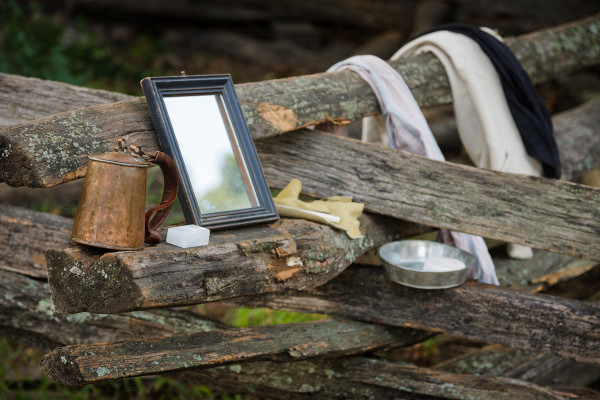
The curious scene unfolded on a recent mid-morning just behind the Public Armoury. Two tradesmen, journeyman tinsmith Steve Delisle and trades interpreter Tim Logue, were preparing to shave. 18th-century style.
Their tools were arranged at the corner of a fence: a kettle of hot water, a block of alum, a mirror, straight razor, soap, and towels.
“What we are showing and hope to be demonstrating regularly is how men in a government facility shaved in the 18th century, and how these government men lived and groomed themselves as they worked, ate, and slept, and shaved at the Public Armoury,” said Tim.
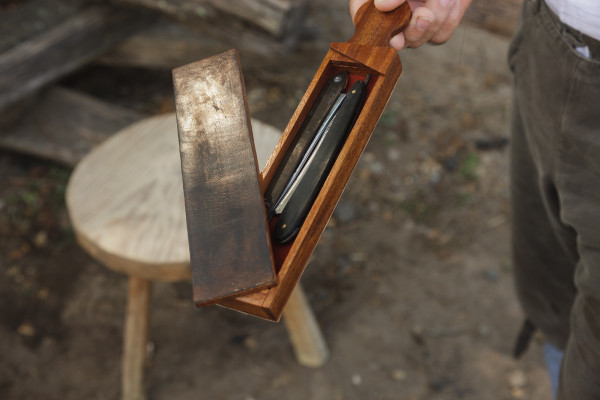
They used actual straight blades dating to the late 18th and early 19th century. Some razors were kept in a box with leather facing that served as a strop to sharpen the blade. In preparation for the demonstration (and because a dull blade is to be despised), Steve sharpened his razor on a stone to the sharpness of a surgeon’s scalpel.
Steve said it was rare to go to the stone. In most cases you would just use the strop if the blade started pulling a bit. Then again, the razors they were using were quite old, and noticeably thinner than they started out, having been sharpened countless times over the years.
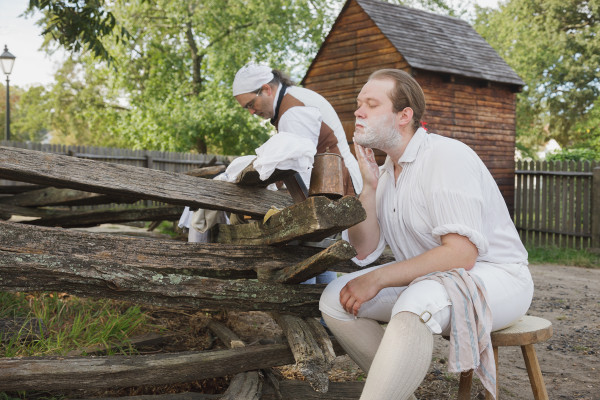
Unlike today’s do-it-yourself routine, men usually visited a barber to get a shave in the 18th century. A towel, dipped in hot water and applied to the face, softened the beard. Then you would rub on some well-lathered soap to get the skin slick.
But the old-fashioned brush to apply shaving cream wasn’t part of the process yet. “We are still trying to document shaving brushes for that period but they do not seem to be common if they were used at all,” said Tim. “There is an obscure mention in a memoir of French barbers in London using them as early as the 1750s but that’s it.”
The strokes are different when you’re shaving yourself rather than getting shaved. If a barber were doing the job, he would have you, the customer, lean back and hold a special wide rim shaving bowl—with a half-round cut-out for the neck—under your chin while he went to work.
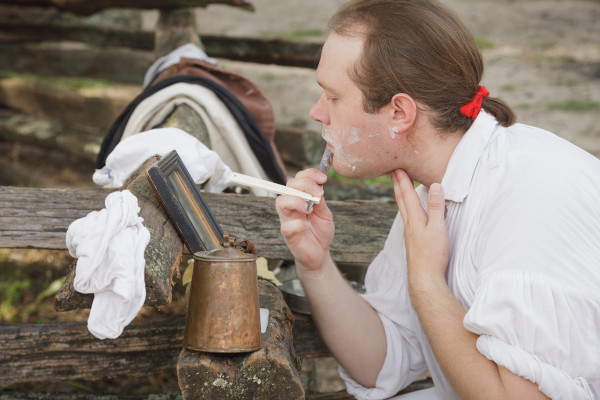
But in this case it’s a small mirror, perhaps six inches high, that Tim was examining as he approached his beard from different angles. It takes practice, and he confessed that this shave wasn’t as effective as it might have been if he used the straight razor more often.
Steve was pulling his skin taut each time he made a pass with the razor in order to make the skin surface as tight and flat as possible. But occasionally you’re going to get cut shaving, no matter what kind of blade you use. Tim got a pretty good nick on the side of his face that continued to bleed as we talked. “I let my guard down for a second near the end,” he said, as he reached for the nearby block of alum. It’s an astringent, similar to the styptic pencil you still occasionally see today. Tim wet the end, applied it to the cut, and soon the blood coagulated.
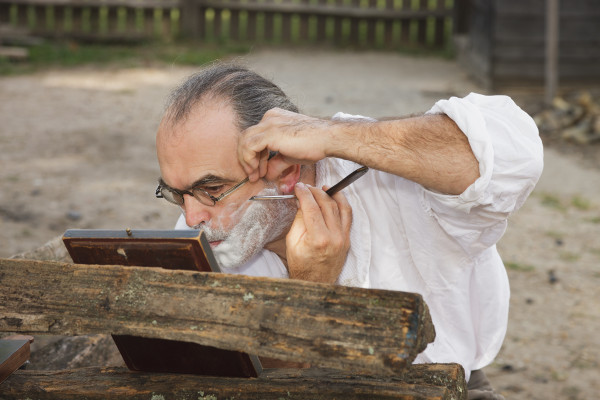
In the 18th century, clean-shaven faces were the norm. It was respectable, just as it was to dress according to societal standards. It’s a reasonable guess that most men shaved every two or three days. There were exceptions. Sailors often had beards, and some religious sects, such as Anabaptists, required them. In European armies, facial hair distinguished particular regiments. Grenadiers, for example, grew mustaches.
Historic trades are all about exploring traditional methods with period tools. Taking your time to explore the streets of Williamsburg, you’ll discover things you didn’t even know you were looking for.
Photographs by Darnell Vennie, Colonial Williamsburg Photo Services
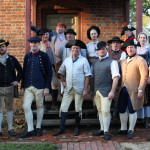


Mike Welch says
Where might a reenactor find such a beautiful razor, and or kit?
Gary says
What about if people had acne they must of cut up their faces pretty bad
Tulio says
Great article!
Does anybody know any data about shaving before the invention of the razor -1740- we reenact Catalán armies of the 1700, so any evidence/clue would be useful to me!
Thanks
Thanks for the question. I asked Tim and here’s what he had to say: “Razors have existed for many thousands of years. Steel razors can be traced back to the time of the ancient Greeks and Romans. Bronze and copper razors have been found archaeologically which pre-date even those attributed to ancient Greek or Roman sources. Steel razors, such as those used by Colonial Williamsburg in our demonstrations and educational programming are of the same materials and roughly the same design as those which have been used since the Middle Ages and even prior. In short, razors in the 1770s are almost identical to those of the 1740s, 1710s, and earlier.”
Great piece, I’d love to see more like this. (I love this blog from the beginning, but this sort of post is my favorite)
Also I’d love if the site had more integration with WordPress.com accounts as it would be nice to use that sign in and be able to ‘Like’ posts as another way to share content etc.
Thanks very much, we’ll look for ways to do more like this. I’ve also passed on your suggestion to see what might be possible.
Interesting piece, Bill. Confirms the wisdom of growing a beard, then and now.
Yet I am clean shaven. I leave it to others to draw appropriate conclusions!